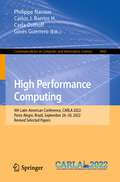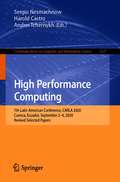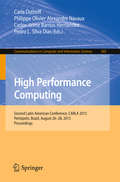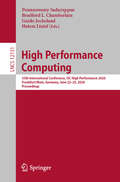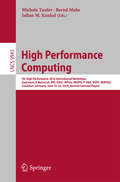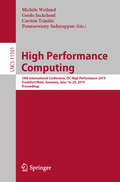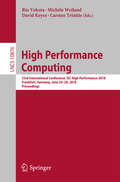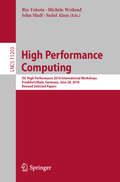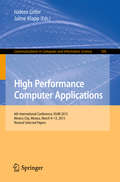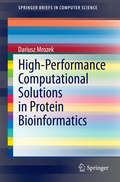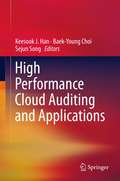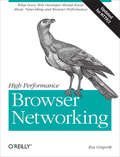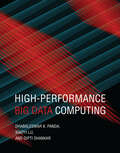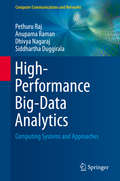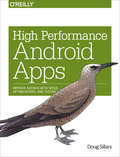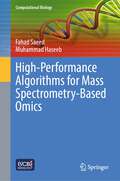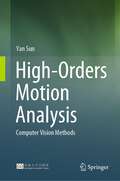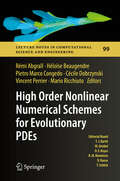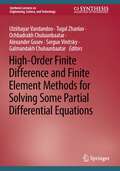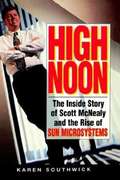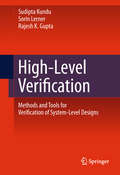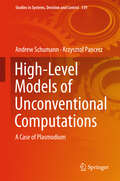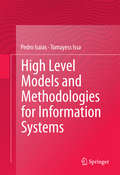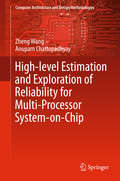- Table View
- List View
High Performance Computing: 9th Latin American Conference, CARLA 2022, Porto Alegre, Brazil, September 26–30, 2022, Revised Selected Papers (Communications in Computer and Information Science #1660)
by Philippe Navaux Carlos J. Barrios H. Carla Osthoff Ginés GuerreroThis book constitutes the proceedings of the 9th Latin American Conference on High Performance Computing, CARLA 2022, held in Porto Alegre, Brazil, in September 2022. The 16 full papers presented in this volume were carefully reviewed and selected from 56 submissions.CARLA, the Latin American High Performance Computing Conference, is an international academic meeting aimed at providing a forum to foster the growth and strength of the High Performance Computing (HPC) community in Latin America and the Caribbean through the exchange and dissemination of new ideas, techniques, and research in HPC and its application areas.
High Performance Computing: 7th Latin American Conference, CARLA 2020, Cuenca, Ecuador, September 2–4, 2020, Revised Selected Papers (Communications in Computer and Information Science #1327)
by Sergio Nesmachnow Harold Castro Andrei TchernykhThis book constitutes revised selected papers of the 7th Latin American High Performance Computing Conference, CARLA 2020, held in Cuenca, Ecuador, in September 2020. Due to the COVID-19 pandemic the conference was held in a virtual mode. The 15 revised full papers presented were carefully reviewed and selected out of 36 submissions. The papers included in this book are organized according to the topics on High Performance Computing Applications; High Performance Computing and Artificial Intelligence.
High Performance Computing
by Pedro L. Silva Dias Carlos Jaime Barrios Hernandez Philippe Olivier Alexandre Navaux Carla OsthoffThis bookconstitutes the proceedings of the Second Latin American Conference on HighPerformance Computing, CARLA 2015, a joint conference of the High-PerformanceComputing Latin America Community, HPCLATAM, and the Conferencia LatinoAmericana de Computación de Alto Rendimiento, CLCAR, held in Petrópolis,Brazil, in August 2015. The 11papers presented in this volume were carefully reviewed and selected from 17 submissions. They were organized in topical sections named: grid andcloud computing; GPU & MIC Computing: methods, libraries and applications;and scientific computing applications.
High Performance Computing: 35th International Conference, ISC High Performance 2020, Frankfurt/Main, Germany, June 22–25, 2020, Proceedings (Lecture Notes in Computer Science #12151)
by Ponnuswamy Sadayappan Bradford L. Chamberlain Guido Juckeland Hatem LtaiefThis book constitutes the refereed proceedings of the 35th International Conference on High Performance Computing, ISC High Performance 2020, held in Frankfurt/Main, Germany, in June 2020.*The 27 revised full papers presented were carefully reviewed and selected from 87 submissions. The papers cover a broad range of topics such as architectures, networks & infrastructure; artificial intelligence and machine learning; data, storage & visualization; emerging technologies; HPC algorithms; HPC applications; performance modeling & measurement; programming models & systems software. *The conference was held virtually due to the COVID-19 pandemic.Chapters "Scalable Hierarchical Aggregation and Reduction Protocol (SHARP) Streaming-Aggregation Hardware Design and Evaluation", "Solving Acoustic Boundary Integral Equations Using High Performance Tile Low-Rank LU Factorization", "Scaling Genomics Data Processing with Memory-Driven Computing to Accelerate Computational Biology", "Footprint-Aware Power Capping for Hybrid Memory Based Systems", and "Pattern-Aware Staging for Hybrid Memory Systems" are available open access under a Creative Commons Attribution 4.0 International License via link.springer.com.
High Performance Computing
by Michela Taufer Bernd Mohr Julian M. KunkelThis book constitutes revised selected papers from 7 workshops that were held in conjunction with the ISC High Performance 2016 conference in Frankfurt, Germany, in June 2016. The 45 papers presented in this volume were carefully reviewed and selected for inclusion in this book. They stem from the following workshops: Workshop on Exascale Multi/Many Core Computing Systems, E-MuCoCoS; Second International Workshop on Communication Architectures at Extreme Scale, ExaComm; HPC I/O in the Data Center Workshop, HPC-IODC; International Workshop on OpenPOWER for HPC, IWOPH; Workshop on the Application Performance on Intel Xeon Phi - Being Prepared for KNL and Beyond, IXPUG; Workshop on Performance and Scalability of Storage Systems, WOPSSS; and International Workshop on Performance Portable Programming Models for Accelerators, P3MA.
High Performance Computing: 34th International Conference, ISC High Performance 2019, Frankfurt/Main, Germany, June 16–20, 2019, Proceedings (Lecture Notes in Computer Science #11501)
by Michèle Weiland Guido Juckeland Carsten Trinitis Ponnuswamy SadayappanThis book constitutes the refereed proceedings of the 34th International Conference on High Performance Computing, ISC High Performance 2019, held in Frankfurt/Main, Germany, in June 2019.The 17 revised full papers presented were carefully reviewed and selected from 70 submissions. The papers cover a broad range of topics such as next-generation high performance components; exascale systems; extreme-scale applications; HPC and advanced environmental engineering projects; parallel ray tracing - visualization at its best; blockchain technology and cryptocurrency; parallel processing in life science; quantum computers/computing; what's new with cloud computing for HPC; parallel programming models for extreme-scale computing; workflow management; machine learning and big data analytics; and deep learning and HPC.
High Performance Computing: 33rd International Conference, ISC High Performance 2018, Frankfurt, Germany, June 24-28, 2018, Proceedings (Lecture Notes in Computer Science #10876)
by Rio Yokota Michèle Weiland David Keyes Carsten TrinitisThis book constitutes the refereed proceedings of the 33rd International Conference, ISC High Performance 2018, held in Frankfurt, Germany, in June 2018. The 20 revised full papers presented in this book were carefully reviewed and selected from 81 submissions. The papers cover the following topics: Resource Management and Energy Efficiency; Performance Analysis and Tools; Exascale Networks; Parallel Algorithms.
High Performance Computing: 33rd International Conference, Isc High Performance 2018, Frankfurt, Germany, June 24-28, 2018, Proceedings (Lecture Notes in Computer Science #10876)
by Rio Yokota Michèle Weiland John Shalf Sadaf AlamThis book constitutes the refereed proceedings of the 33rd International Conference, ISC High Performance 2018, held in Frankfurt, Germany, in June 2018. The 20 revised full papers presented in this book were carefully reviewed and selected from 81 submissions. The papers cover the following topics: Resource Management and Energy Efficiency; Performance Analysis and Tools; Exascale Networks; Parallel Algorithms.
High Performance Computer Applications
by Isidoro Gitler Jaime KlappThis bookconstitutes the refereed proceedings of the 6th International Conference onSupercomputing, ISUM 2015, held in México, Mexico, in March 2015. The 38revised full papers presented were carefully reviewed and selected from 102submissions. The papers are organized in topical sections on perspectives insupercomputer infrastructure and applications; parallel algorithms andoptimization; HPC applications and simulations;
High-Performance Computational Solutions in Protein Bioinformatics
by Dariusz MrozekRecent developments in computer science enable algorithms previously perceived as too time-consuming to now be efficiently used for applications in bioinformatics and life sciences. This work focuses on proteins and their structures, protein structure similarity searching at main representation levels and various techniques that can be used to accelerate similarity searches. Divided into four parts, the first part provides a formal model of 3D protein structures for functional genomics, comparative bioinformatics and molecular modeling. The second part focuses on the use of multithreading for efficient approximate searching on protein secondary structures. The third and fourth parts concentrate on finding 3D protein structure similarities with the support of GPUs and cloud computing. Parts three and four both describe the acceleration of different methods. The text will be of interest to researchers and software developers working in the field of structural bioinformatics and biomedical databases.
High Performance Cloud Auditing and Applications
by Keesook J. Han Baek-Young Choi Sejun SongThis book mainly focuses on cloud security and high performance computing for cloud auditing. The book discusses emerging challenges and techniques developed for high performance semantic cloud auditing, and presents the state of the art in cloud auditing, computing and security techniques with focus on technical aspects and feasibility of auditing issues in federated cloud computing environments. In summer 2011, the United States Air Force Research Laboratory (AFRL) CyberBAT Cloud Security and Auditing Team initiated the exploration of the cloud security challenges and future cloud auditing research directions that are covered in this book. This work was supported by the United States government funds from the Air Force Office of Scientific Research (AFOSR), the AFOSR Summer Faculty Fellowship Program (SFFP), the Air Force Research Laboratory (AFRL) Visiting Faculty Research Program (VFRP), the National Science Foundation (NSF) and the National Institute of Health (NIH). All chapters were partially supported by the AFOSR Information Operations and Security Program extramural and intramural funds (AFOSR/RSL Program Manager: Dr. Robert Herklotz). Key Features: · Contains surveys of cyber threats and security issues in cloud computing and presents secure cloud architectures · Presents in-depth cloud auditing techniques, federated cloud security architectures, cloud access control models, and access assured information sharing technologies · Outlines a wide range of challenges and provides solutions to manage and control very large and complex data sets
High Performance Browser Networking: What every web developer should know about networking and web performance
by Ilya GrigorikHow prepared are you to build fast and efficient web applications? This eloquent book provides what every web developer should know about the network, from fundamental limitations that affect performance to major innovations for building even more powerful browser applications--including HTTP 2.0 and XHR improvements, Server-Sent Events (SSE), WebSocket, and WebRTC. Author Ilya Grigorik, a web performance engineer at Google, demonstrates performance optimization best practices for TCP, UDP, and TLS protocols, and explains unique wireless and mobile network optimization requirements. You'll then dive into performance characteristics of technologies such as HTTP 2.0, client-side network scripting with XHR, real-time streaming with SSE and WebSocket, and P2P communication with WebRTC. Deliver superlative TCP, UDP, and TLS performance Speed up network performance over 3G/4G mobile networks Develop fast and energy-efficient mobile applications Address bottlenecks in HTTP 1.x and other browser protocols Plan for and deliver the best HTTP 2.0 performance Enable efficient real-time streaming in the browser Create efficient peer-to-peer videoconferencing and low-latency applications with real-time WebRTC transports
High-Performance Big Data Computing (Scientific and Engineering Computation)
by Dhabaleswar K. Panda Xiaoyi Lu Dipti ShankarAn in-depth overview of an emerging field that brings together high-performance computing, big data processing, and deep lLearning. Over the last decade, the exponential explosion of data known as big data has changed the way we understand and harness the power of data. The emerging field of high-performance big data computing, which brings together high-performance computing (HPC), big data processing, and deep learning, aims to meet the challenges posed by large-scale data processing. This book offers an in-depth overview of high-performance big data computing and the associated technical issues, approaches, and solutions. The book covers basic concepts and necessary background knowledge, including data processing frameworks, storage systems, and hardware capabilities; offers a detailed discussion of technical issues in accelerating big data computing in terms of computation, communication, memory and storage, codesign, workload characterization and benchmarking, and system deployment and management; and surveys benchmarks and workloads for evaluating big data middleware systems. It presents a detailed discussion of big data computing systems and applications with high-performance networking, computing, and storage technologies, including state-of-the-art designs for data processing and storage systems. Finally, the book considers some advanced research topics in high-performance big data computing, including designing high-performance deep learning over big data (DLoBD) stacks and HPC cloud technologies.
High-Performance Big-Data Analytics
by Pethuru Raj Anupama Raman Dhivya Nagaraj Siddhartha DuggiralaThis book presents a detailed review of high-performance computing infrastructures for next-generation big data and fast data analytics. Features: includes case studies and learning activities throughout the book and self-study exercises in every chapter; presents detailed case studies on social media analytics for intelligent businesses and on big data analytics (BDA) in the healthcare sector; describes the network infrastructure requirements for effective transfer of big data, and the storage infrastructure requirements of applications which generate big data; examines real-time analytics solutions; introduces in-database processing and in-memory analytics techniques for data mining; discusses the use of mainframes for handling real-time big data and the latest types of data management systems for BDA; provides information on the use of cluster, grid and cloud computing systems for BDA; reviews the peer-to-peer techniques and tools and the common information visualization techniques, used in BDA.
High Performance Android Apps
by Doug SillarsUnique and clever ideas are important when building a hot-selling Android app, but the real drivers for success are speed, efficiency, and power management. <P><P>With this practical guide, you'll learn the major performance issues confronting Android app developers, and the tools you need to diagnose problems early.Customers are finally realizing that apps have a major role in the performance of their Android devices. Author Doug Sillars not only shows you how to use Android-specific testing tools from companies including Google, Qualcomm, and AT&T, but also helps you explore potential remedies. You'll discover ways to build apps that run well on all 19,000 Android device types in use.Understand how performance issues affect app sales and retentionBuild an Android device lab to maximize UI, functional, and performance testingImprove the way your app interacts with device hardwareOptimize your UI for fast rendering, scrolling, and animationsTrack down memory leaks and CPU issues that affect performanceUpgrade communications with the server, and learn how your app performs on slower networksApply Real User Monitoring (RUM) to ensure that every device is delivering the optimal user experience
High-Performance Algorithms for Mass Spectrometry-Based Omics (Computational Biology)
by Fahad Saeed Muhammad HaseebTo date, processing of high-throughput Mass Spectrometry (MS) data is accomplished using serial algorithms. Developing new methods to process MS data is an active area of research but there is no single strategy that focuses on scalability of MS based methods. Mass spectrometry is a diverse and versatile technology for high-throughput functional characterization of proteins, small molecules and metabolites in complex biological mixtures. In the recent years the technology has rapidly evolved and is now capable of generating increasingly large (multiple tera-bytes per experiment) and complex (multiple species/microbiome/high-dimensional) data sets. This rapid advance in MS instrumentation must be matched by equally fast and rapid evolution of scalable methods developed for analysis of these complex data sets. Ideally, the new methods should leverage the rich heterogeneous computational resources available in a ubiquitous fashion in the form of multicore, manycore, CPU-GPU, CPU-FPGA, and IntelPhi architectures. The absence of these high-performance computing algorithms now hinders scientific advancements for mass spectrometry research. In this book we illustrate the need for high-performance computing algorithms for MS based proteomics, and proteogenomics and showcase our progress in developing these high-performance algorithms.
High-Orders Motion Analysis: Computer Vision Methods
by Yan SunThis book shows how different types of motion can be disambiguated into their components in a richer way than that currently possible in computer vision. Previous research of motion analysis has generally not yet considered the basic nature of higher orders of motion such as acceleration. Hence, this book introduces an approximation of the acceleration field using established optical flow techniques. Further, acceleration is decomposed into radial and tangential based on geometry and propagated as a general motion descriptor; this book shows the capability for differentiating different types of motion both on synthesized data and real image sequences. Beyond acceleration, the higher orders of motion flow and their continuant parts are investigated for further revealing the chaotic motion fields. Naturally, it is possible to extend this notion further: to detect higher orders of image motion. In this respect, this book shows how jerk and snap can be obtained from image sequences. The derived results on test images and heel strike detection in gait analysis illustrate the ability of higher-order motion, which provide the basis for the following research and applications in the future. We hope that the publication of this book will bring a new perspective to researchers and graduate students in the field of video analysis in computer vision.
High Order Nonlinear Numerical Schemes for Evolutionary PDEs
by Rémi Abgrall Héloïse Beaugendre Pietro Marco Congedo Cécile Dobrzynski Vincent Perrier Mario RicchiutoThis book collects papers presented during the European Workshop on High Order Nonlinear Numerical Methods for Evolutionary PDEs (HONOM 2013) that was held at INRIA Bordeaux Sud-Ouest, Talence, France in March, 2013. The central topic is high order methods for compressible fluid dynamics. In the workshop, and in this proceedings, greater emphasis is placed on the numerical than the theoretical aspects of this scientific field. The range of topics is broad, extending through algorithm design, accuracy, large scale computing, complex geometries, discontinuous Galerkin, finite element methods, Lagrangian hydrodynamics, finite difference methods and applications and uncertainty quantification. These techniques find practical applications in such fields as fluid mechanics, magnetohydrodynamics, nonlinear solid mechanics, and others for which genuinely nonlinear methods are needed.
High-Order Finite Difference and Finite Element Methods for Solving Some Partial Differential Equations (Synthesis Lectures on Engineering, Science, and Technology)
by Ulziibayar Vandandoo Tugal Zhanlav Ochbadrakh Chuluunbaatar Alexander Gusev Sergue Vinitsky Galmandakh ChuluunbaatarThe monograph is devoted to the construction of the high-order finite difference and finite element methods for numerical solving multidimensional boundary-value problems (BVPs) for different partial differential equations, in particular, linear Helmholtz and wave equations, nonlinear Burgers’ equations, and elliptic (Schrödinger) equation. Despite of a long history especially in development of the theoretical background of these methods there are open questions in their constructive implementation in numerical solving the multidimensional BVPs having additional requirement on physical parameters or desirable properties of its approximate solutions. Over the last two decades many papers on this topics have been published, in which new constructive approaches to numerically solving the multidimensional BVPs were proposed, and its highly desirable to systematically collect these results. This motivate us to write thus monograph based on our research results obtained in collaboration with the co-authors. Since the topic is importance we believe that this book will be useful to readers, graduate students and researchers interested in the field of computational physics, applied mathematics, numerical analysis and applied sciences
High Noon: The Inside Story of Scott McNealy and the Rise of Sun Microsystems
by Karen SouthwickThe story of Sun Microsystems, the famous IT company, that grew from scratch and became a leader in the computer industry. It also reveals the strategies they adopted to become leaders.
High-Level Verification
by Sorin Lerner Sudipta Kundu Rajesh K. GuptaGiven the growing size and heterogeneity of Systems on Chip (SOC), the design process from initial specification to chip fabrication has become increasingly complex. This growing complexity provides incentive for designers to use high-level languages such as C, SystemC, and SystemVerilog for system-level design. While a major goal of these high-level languages is to enable verification at a higher level of abstraction, allowing early exploration of system-level designs, the focus so far for validation purposes has been on traditional testing techniques such as random testing and scenario-based testing. This book focuses on high-level verification, presenting a design methodology that relies upon advances in synthesis techniques as well as on incremental refinement of the design process. These refinements can be done manually or through elaboration tools. This book discusses verification of specific properties in designs written using high-level languages, as well as checking that the refined implementations are equivalent to their high-level specifications. The novelty of each of these techniques is that they use a combination of formal techniques to do scalable verification of system designs completely automatically. The verification techniques presented in this book include methods for verifying properties of high-level designs and methods for verifying that the translation from high-level design to a low-level Register Transfer Language (RTL) design preserves semantics. Used together, these techniques guarantee that properties verified in the high-level design are preserved through the translation to low-level RTL.
High-Level Models of Unconventional Computations: A Case Of Plasmodium (Studies in Systems, Decision and Control #159)
by Krzysztof Pancerz Andrew SchumannThis book shows that the plasmodium of Physarum polycephalum can be considered a natural labelled transition system, and based on this, it proposes high-level programming models for controlling the plasmodium behaviour. The presented programming is a form of pure behaviourism: the authors consider the possibility of simulating all basic stimulus–reaction relations. As plasmodium is a good experimental medium for behaviouristic models, the book applies the programming tools for modelling plasmodia as unconventional computers in different behavioural sciences based on studying the stimulus–reaction relations. The authors examine these relations within the framework of a bio-inspired game theory on plasmodia they have developed i.e. within an experimental game theory, where, on the one hand, all basic definitions are verified in experiments with Physarum polycephalum and Badhamia utricularis and, on the other hand, all basic algorithms are implemented in the object-oriented language for simulations of plasmodia. The results allow the authors to propose that the plasmodium can be a model for concurrent games and context-based games.
High Level Models and Methodologies for Information Systems
by Pedro Isaias Tomayess IssaIn this book the authors introduce and explain many methods and models for the development of Information Systems (IS). It was written in large part to aid designers in designing successful devices/systems to match user needs in the field. Chief among these are website development, usability evaluation, quality evaluation and success assessment. The book provides great detail in order to assist readers' comprehension and understanding of both novel and refined methodologies by presenting, describing, explaining and illustrating their basics and working mechanics. Furthermore, this book presents many traditional methods and methodologies in an effort to make up a comprehensive volume on High Level Models and Methodologies for Information Systems. The target audience for this book is anyone interested in conducting research in IS planning and development. The book represents a main source of theory and practice of IS methods and methodologies applied to these realities. The book will appeal to a range of professions that are involved in planning and building the information systems, for example information technologists, information systems developers, as well as Web designers and developers--both researchers and practitioners; as a consequence, this book represents a genuinely multi-disciplinary approach to the field of IS methods and methodologies.
High-level Estimation and Exploration of Reliability for Multi-Processor System-on-Chip
by Zheng Wang Anupam ChattopadhyayThis book introduces a novel framework for accurately modeling the errors in nanoscale technology and developing a smooth tool flow at high-level design abstractions to estimate error effects, which aids the development of high-level fault-tolerant techniques. In total, the book presents 6 solutions for reliability estimation (3 for fault injection and 3 for analytical estimation) and 5 techniques for reliability exploration (3 for architectural level and 2 for system-level). It also presents a survey of state-of-the-art problems and solutions, offering insights into reliability issues in digital design and their cross-layer countermeasures.
High Impact Marketing That Gets Results
by Ardi KolahThis book will help you to use tried and tested no-fuss marketing methods to boost awareness of your brand among new and established customers. We'll give you the confidence to segment your market and customers so you can choose the right strategies for your business, products and services. You'll learn how to avoid costly mistakes with effective research and a practical marketing plan as well as how to use online marketing, PR, direct mail, promotions and other tools to run effective marketing campaigns that deliver measurable results. Jargon free, accessible, no detailed knowledge required, signposts the reader to all the important bits. The GURU is out of the BOTTLE!
